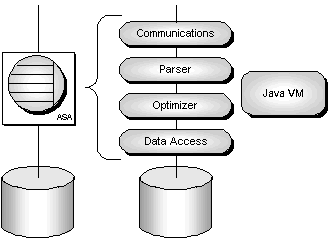







ASA Getting Started
The Architecture of Database Applications
Inside Adaptive Server Anywhere
The Adaptive Server Anywhere database server has an internal structure that allows many requests to be handled efficiently.
A communications layer handles the actual exchange of data with client applications. This layer receives requests from client applications, and returns results. The timing of these actions is governed by a negotiation between client and server to make sure that the network traffic is kept to a minimum, but that the data is made available as soon as possible on the client side.
The parser checks each SQL statement sent to the database server, and transforms it into an internal form for processing.
If the request is a query, an update, or delete statement, there may be many different ways of accessing the data, which may take massively different times. The job of the optimizer is to select from among all these possibilities the best route to getting the required data quickly.
A Java Virtual Machine is built into the database server, and any Java operations sent by client applications, or invoked internally by the database server, are handled by the Java VM.
The lowest level of the database server is concerned with reading and writing data from the disk, caching data in memory to avoid unnecessary disk access, and balancing the demands of different users.




